Streamline AP processes with 3-way match automation
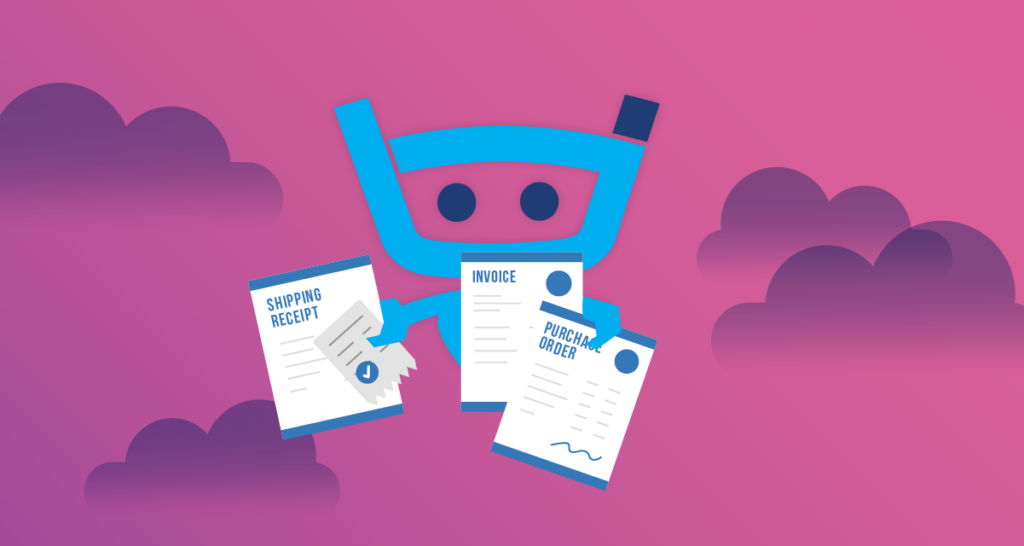
Are invoice errors costing you time and money?
The last thing you want to do is pay for something you didn’t receive, or even worse, send money to a fraudster. Automated three-way matching helps you detect and fix erroneous, fraudulent, and duplicate invoices. It streamlines the internal controls used to verify invoices and purchase orders and removes error-prone manual verification tasks.
By flagging mismatches, discrepancies, and duplicates before a payment is made, automated three-way matching saves your business time and money and prevents unwelcome and costly surprises.
Read on to learn more about automating the three-way match process. We’ll explore the matching process and the benefits of automation and share some tips on making the most of automating three-way matching in your business.
What is 3-way matching in accounts payable?
If you’re in business, the odds are you’ll be the victim of fraud at some point. In a 2023 survey on payment fraud by the Association for Financial Professionals, 65% of organizations reported companies reported being targeted by payment fraud attacks or attempts.
Three-way matching is an internal control that ensures what was ordered from a supplier matches what was received and what the supplier is charging. The three-way matching process verifies each transaction by comparing information from three documents: the purchase order (PO), the shipping receipt or goods received notice (GRN), and the supplier invoice. If this information matches, the accounts payable department processes the invoice for approvals and payment. If the information doesn’t match, AP investigates and addresses the discrepancy.
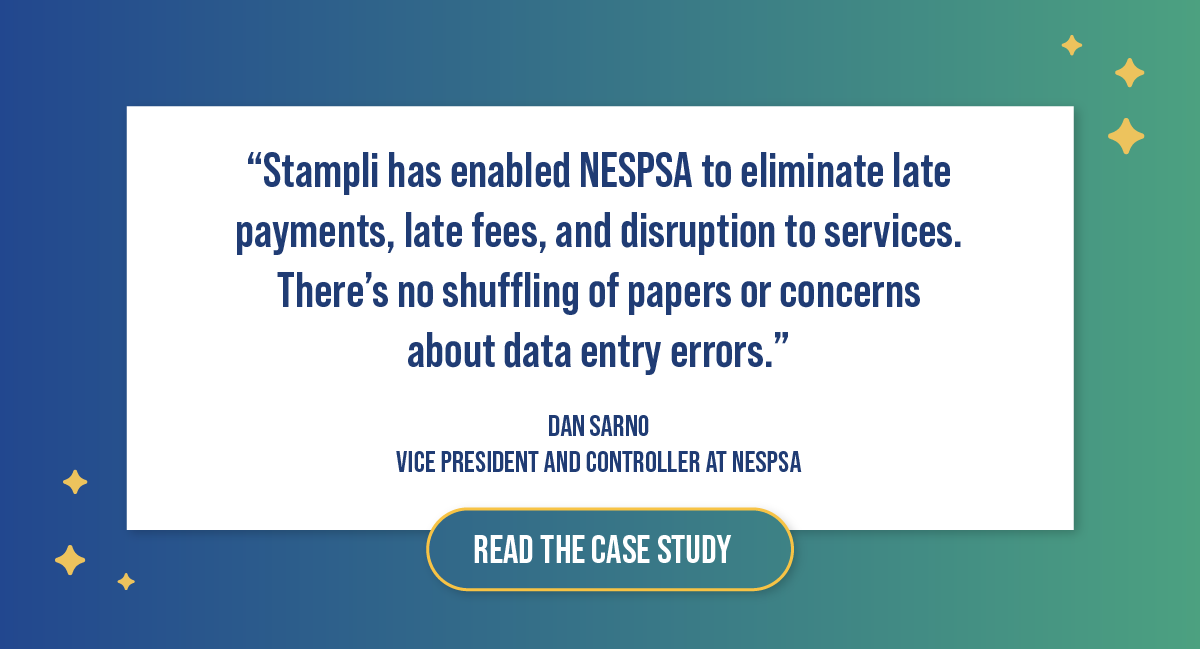
How the 3-way match process works
Three-way matching involves comparing the PO, shipping receipt, and invoice data. We can divide the information into two categories:
- Header data: Company name and address, date, PO number, invoice number, and payment terms. The header may also contain the total amount due and tax information.
- Line data: Descriptions of products or services ordered or delivered, along with quantities, rates, prices, and additional information.
To verify a transaction, the accounts payable department checks each document to see if the header and line data matches the associated data on the other two documents.
Purchase Order (PO)
The PO is a legally binding document that confirms the types, quantities, and agreed prices for the products or services required to the supplier. It contains header information and line items such as product or service descriptions, pricing, GL codes, and quantities.
Data checked: Does the purchase order include the total due amount, the supplier’s name and address, the correct GL codes, accurate descriptions of the products or services, and any other required info?
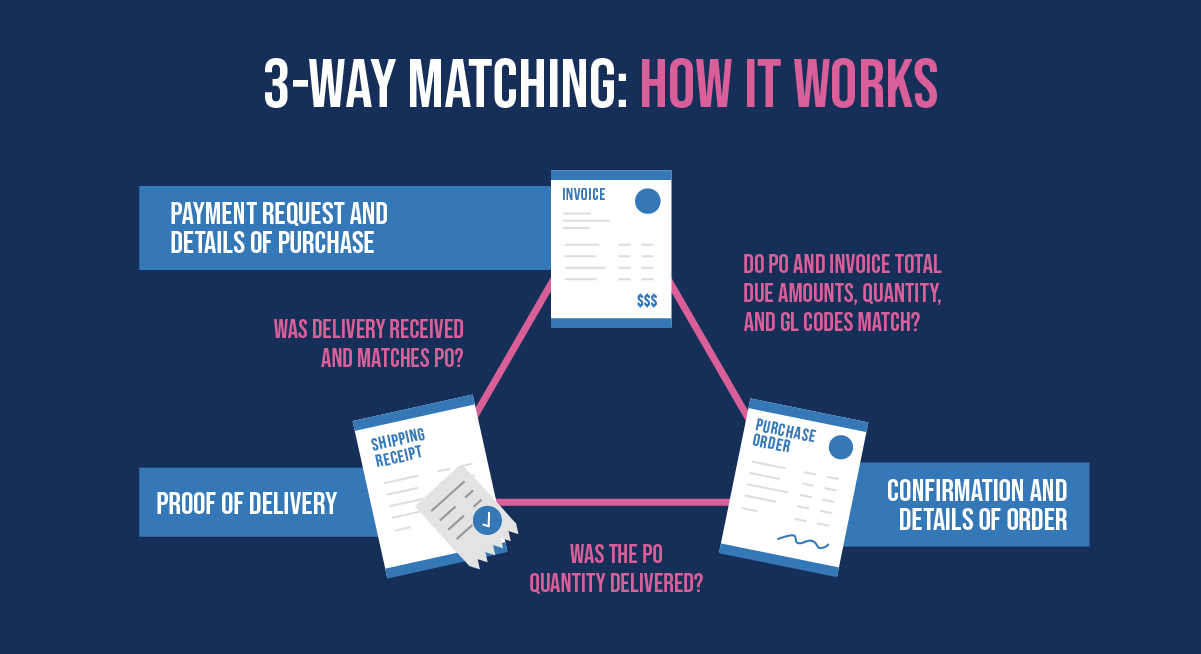
Shipping documents
Shipping documents such as the shipping receipt, Goods Received Note (GRN), delivery receipt, or packing slip confirm the supplier has delivered the product or service. It contains the same information as the purchase order but may contain additional delivery information. The shipping receipt may include products and services for multiple or partial POs.
Data checked: Do the products, quantities, and prices match the line items on the PO? If not, does the shipping receipt explain why there’s a difference (item back-ordered, out of stock)?
Supplier Invoice
The supplier sends the invoice after delivering the goods or services. The invoice details usually contain the same line item information as the PO and shipping receipt, along with the invoice number, vendor name and address, credit details, taxes, discounts, and payment schedule.
Data checked: Does the total due amount match the amount authorized on the PO? Do the products, quantities, and prices match the PO and shipping receipt? Is the invoice for more than one PO or part of a single PO? If the supplier sent a partial shipment, are they asking for partial or full payment?
How to handle discrepancies
If the details of the three documents match, the AP team sends the invoice for approval and payment. If any exceptions are found, AP holds the vendor invoice while they investigate and resolve the issue. The resolution process can include the vendor and internal procurement and receiving teams.
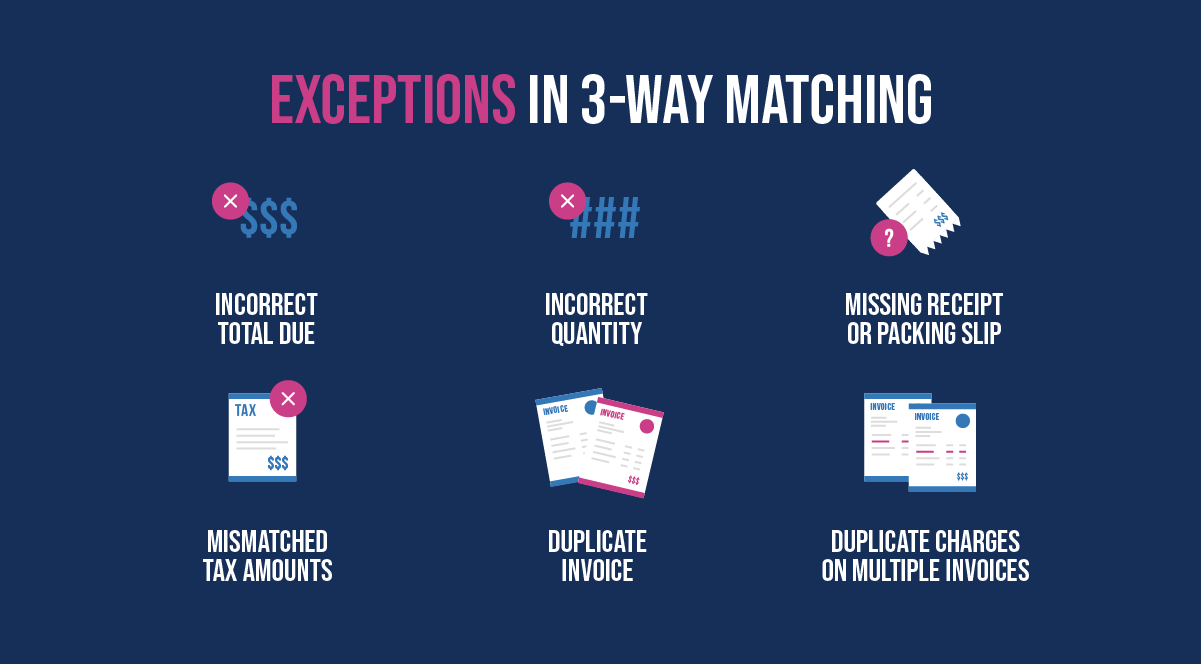
Example of 3-way matching
To illustrate how three-way matching works, here’s a simple example of the process.
A furniture manufacturer sends its supplier a purchase order for 400 brass hinges with a total cost of $2,000. The supplier ships the hinges and then sends the manufacturer an invoice.
When they get the invoice, the manufacturer’s AP team compares it to the purchase order. They confirm that the supplier information is correct, the invoice is for 400 brass hinges, and the total due is $2000.
Next, the AP team emails a copy of the invoice to the receiving team. The receiving team compares the invoice to the shipping receipt and discovers that the supplier sent 400 steel hinges instead of brass ones.
The AP team halts the invoice payment and informs the procurement team of the discrepancy. The procurement team contacts the supplier, who rushes a shipment of 400 brass hinges to the manufacturer.
When the rush order of brass hinges arrives, the AP and receiving teams verify the new shipping receipt matches the invoice. If the documents match, the AP team forwards the invoice for approval and payment.
Two-way and four-way matching
Three-way matching is an effective and efficient way to verify invoices. However, it might not meet every company’s needs. Let’s look at situations where two-way matching or four-way matching may be a better choice.
When should you use 2-way or 4-way matching?
Although three-way matching is the usual way of matching invoices, 2-way or 4-way can be a better choice for your business in certain situations.
When to use 2-way matching
In two-way matching, the AP department compares the invoice to the purchase order. Use two-way matching when:
- You want to save time and money: Two-way matching is faster and uses fewer resources than three-way matching. Companies that receive large numbers of invoices can use it to reduce invoice processing time and costs.
- You are purchasing services: Service suppliers don’t usually send shipping receipts because they aren’t delivering products. Because it requires shipping documents, three-way matching is typically not used for services.
- You’re dealing with a trusted or integrated supplier: Three-way matching may not be needed in situations where the chance of errors and fraud is low. For example, inventory control or supply chain management systems can often detect and flag discrepancies between POs and shipping receipts from integrated suppliers. Trusted suppliers may also take a proactive approach to ensuring shipping accuracy, further reducing the risk of errors.
- You are using AP automation with automatic approval thresholds: AP automation platforms like Stampli can expedite the two-way match process by automatically approving invoices and POs that match exactly. Skipping the approval stage significantly speeds up payment processing.
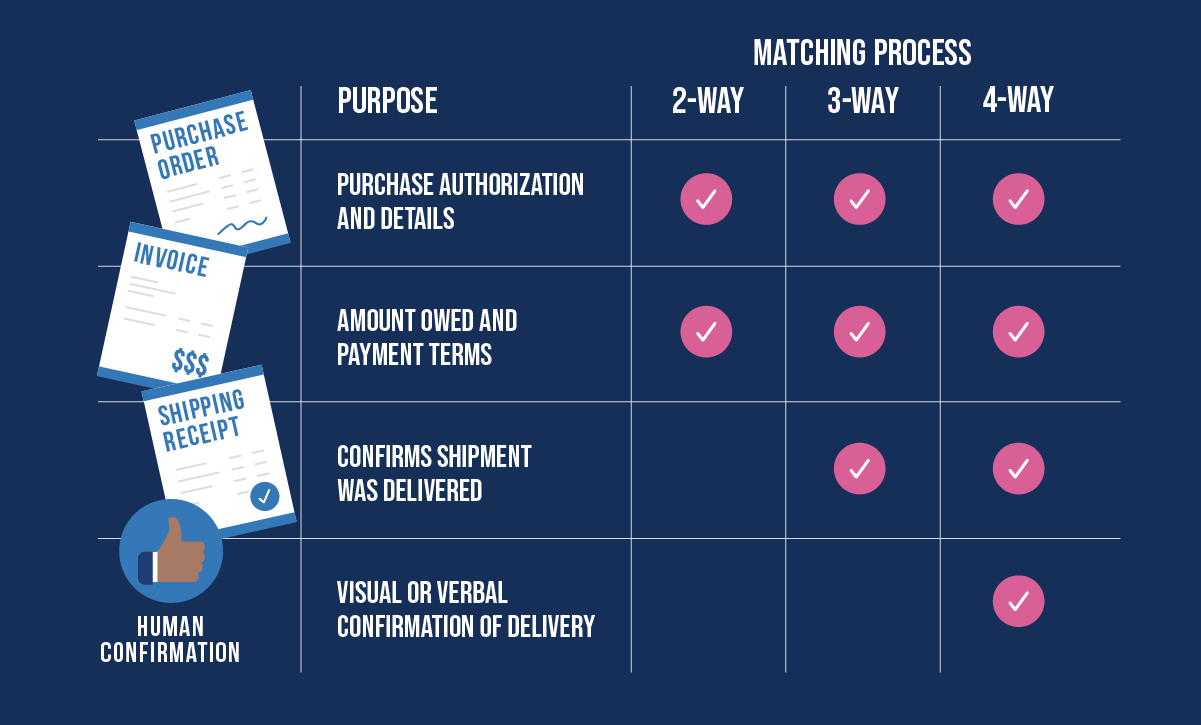
When to use 4-way matching
Four-way matching adds a manual verification step to three-way matching. It is used when additional details are needed to confirm the information on the invoice, PO, or shipping receipt. Use four-way matching when:
- You require quality assurance inspections: Add a step to verify inspection reports if your PO or QA processes require input products to meet standards, specifications, or quality tolerances before your business will accept them.
For example, most sustainability standards require manufacturers to confirm they are using sustainably sourced inputs in their production processes. - You want to mitigate risk for large orders: Prevent fraud and reduce the impact of errors by adding a mandatory physical spot check to the three-way matching process for orders over a certain value threshold.
For example, a company orders $30,000,000 in computer printers and has its receiving team perform a physical count of the printers when the shipment arrives. - You want to add tolerance limits in your supply chain: A tolerance limit is how much variance a company will allow between a purchase order and what is shipped or invoiced. Setting tolerance limits can help companies protect themselves from fraud or errors while maintaining an efficient accounts payable process.
For example, a construction company with a 5% tolerance limit for lumber purchases orders 200 sheets of plywood. They get 215 sheets, which is 7.5% above the amount they ordered and exceeds their tolerance limit. In response, they investigate the shipment to see if there’s an error or signs of fraud.
Manual invoice matching can be a powerful and effective tool. However, it can also be a time-consuming and error-prone process. Searching through paperwork for invoices, POs, and shipping receipts, visually checking each document to make sure they match, and investigating when they don’t can tie up your entire AP department. And as the number of invoices and shipments increases, so does the chance of errors and fraud.
AP automation is the solution. By streamlining AP processes and automating invoice matching, automation lets your AP team work faster with less human error.
Improve 3-way matching with accounts payable automation
AP automation solutions replace manual invoice processing by using AI and machine learning to scan, GL code, and enter and store invoices automatically. They optimize three-way automatically by comparing each invoice against its associated purchase order, flagging discrepancies for your AP department to investigate.
Benefits of automated 3-way matching
Automating the manual matching process saves time and money by optimizing manual processes and reducing errors. Instead of AP clerks searching file cabinets for paper documents or having them go through hundreds of emails to find a PDF attachment, an automated system can do the job instantly. Here are the key benefits of switching to an automated matching process.
Improve supplier relationships
Verifying each invoice helps you identify and address problems with your P2P processes and supply chain. For example, your system may identify a recurring error in a supplier’s invoices, allowing you to resolve the problem with the supplier and improve payment times.
Better profitability
Improving invoice processing times helps you pay bills quicker, meaning you can save money (and increase profits) through early payment discounts and avoiding late payment fees.
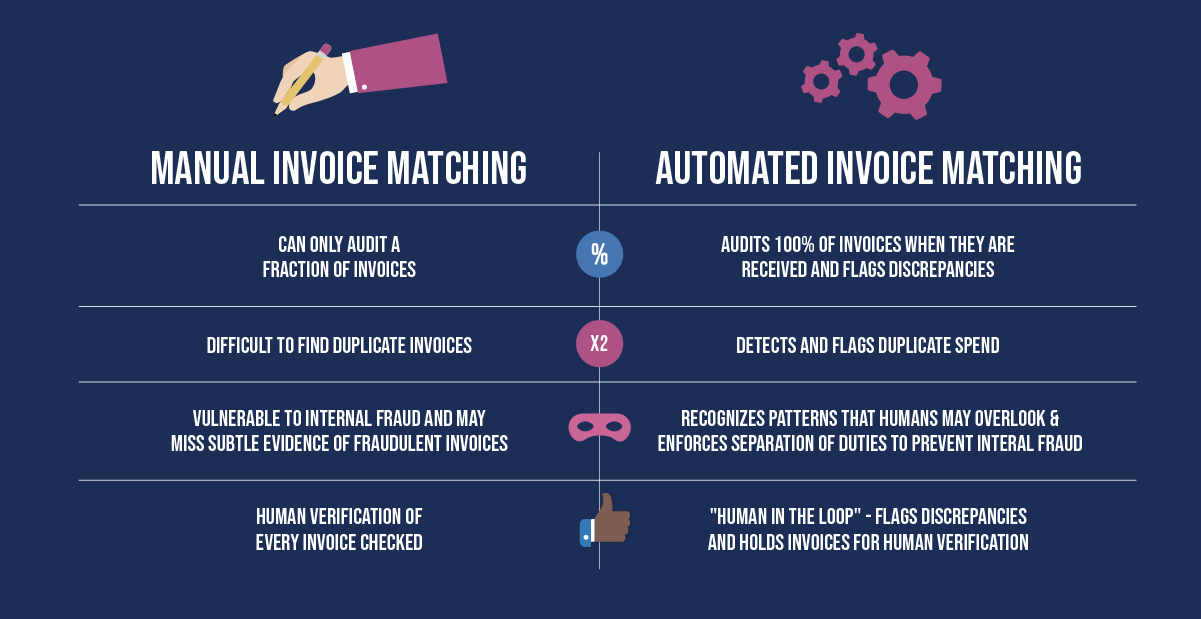
Improved cash flow
Verifying invoices means fewer invoice errors and less chance of duplicate payments or overpayments, which is great for managing cash flow.
Protection from fraud
AI-powered AP automation software detects subtle signs of fraud that human reviewers may miss. They also simplify AP audits by automatically capturing and tracking all documents, actions, and communications in a single location.
Easy integration with ERPs
AP automation solutions integrate with ERPs and business systems to share business data automatically in real-time. By providing easy access to shipping and inventory data, integration makes it easier for AP teams to compare invoices, POs, and shipping receipts.
Fast approvals
AP platforms automatically notify approvers when an invoice has been verified, saving them the extra step of manually confirming verification.
Tips for more efficient automated invoice matching
Automated 3-way invoice matching can provide significant savings and process improvements. Here are a few ways to get even more out of your AP automation solution.
Use 2-way matching to expedite exact matches
AP solutions like Stampli can be configured to skip the approval stage for invoices that match the associated purchase order exactly. Skipping approvals speeds up invoice processing and payment times and reduces approvers’ workloads.
Set value thresholds or preferred vendors to skip matching
You can configure your AP platform to skip the invoice matching step for invoices below a specific threshold or from a highly trusted vendor. The invoice will be automatically forwarded for approval once it has been entered.
Keep customer and invoice data clean
The best AP automation solution is only as good as the data you put in it. Missing or incorrect data can result in invoice errors that take time and money to resolve. Invest in an automated vendor management solution to ensure vendor data is accurate and up to date. Also, check user reviews to identify AP platforms with a reputation for good invoice scanning and processing accuracy.
Ensure documents are easy to find
Keep up-to-date versions of contracts, licenses, and other vendor documents in a central location. Doing this makes resolving invoice errors such as incorrect pricing or credit terms easier for AP teams.
Stampli: your ideal match for invoice matching
Stampli is the only Accounts Payable Automation solution designed to meet the evolving needs of modern accounts payable teams. Stampli simplifies invoice management by removing the need for external communication, ad-hoc solutions, and manual AP tasks. It allows AP teams to see every transaction and makes invoice matching, audits, and invoice approval processes effortless, enabling you to make informed strategic business decisions and improve vendor relationships.
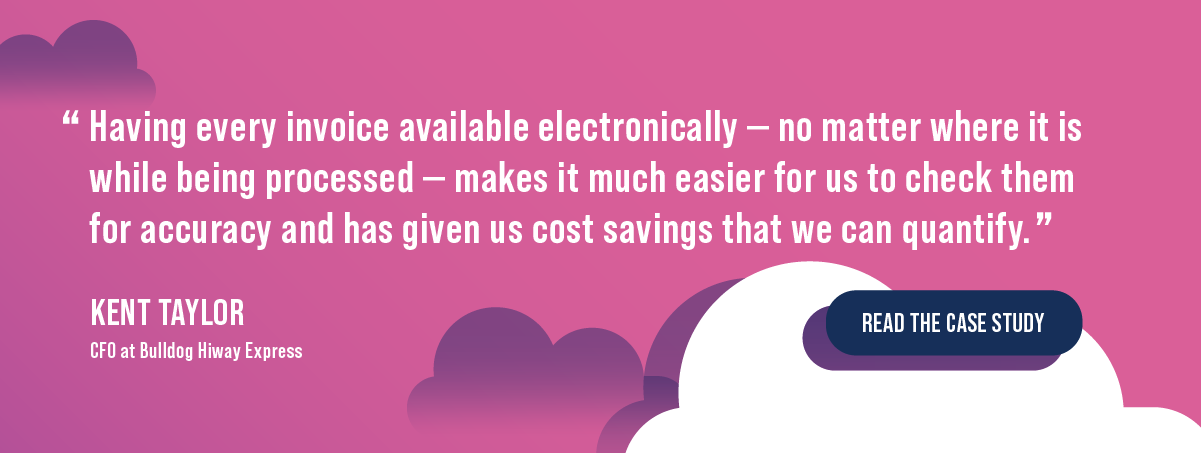
Effortless 2 and 3-way matching
Stampli directly provides real-time PO data on the invoice page, letting your AP team perform 2- or 3-way matching and adapt to your unique PO requirements. Traditionally, companies have struggled with getting visibility into POs and related documents – causing errors and delays while employees tried to reconcile POs and invoices. As a result, many companies either accommodate variances or make adjustments when coding.
Stampli’s AI solution automatically extracts the relevant PO information from invoices and has the flexibility to make line-level adjustments, apply multiple POs to one invoice, or bill multiple invoices to a single PO. It reduces coding errors, ensures accurate processing, and facilitates easy collaboration between departments to resolve discrepancies while automatically updating the PO status in your ERP.
Human-in-the-loop invoice verification with Billy the Bot
Stampli is easy to learn and user-friendly with the help of Billy the Bot™. Powered by AI and machine learning, Billy efficiently captures and categorizes data from paper and electronic receipts. He can also understand different line types, including general ledger, charges, and resources, and handle partial payment workflows and multiple POs.
Billy is a powerful ally against fraud. He detects signs of fraud and errors that are often easily missed, such as slight changes to invoice information or inflated line items, and flags them for further investigation by AP team members. With Stampli’s industry-leading collaboration and analysis functionality, this empowers AP and purchasing departments to catch and stop fraudulent invoices before they get paid.
The case studies speak for themselves. Stampli delivers real results by helping businesses optimize invoice processing without changing their ERP system or AP processes. Contact us today to set up a free demo.